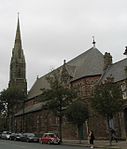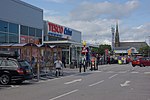Ramsden Square
History of Barrow-in-FurnessProtected areas of CumbriaStreets in Barrow-in-FurnessUse British English from October 2017

Ramsden Square is a square located at the intersection of Abbey Road and Duke Street in Barrow-in-Furness, Cumbria, England. It marks the boundary of the Central and Hindpool wards and now acts as a major roundabout. Ramsden Square was first laid out in the 1840s to act as a focal point of Sir James Ramsden's master plan for the new town of Barrow, separating its burgeoning industries and commercial core. The centerpiece of the square is a statue of Ramsden himself while it is framed by a number of historic buildings including Barrow Central Library, the National Westminster Bank Building and formerly the Barrow Jute Works.
Excerpt from the Wikipedia article Ramsden Square (License: CC BY-SA 3.0, Authors, Images).Ramsden Square
Geographical coordinates (GPS) Address Nearby Places Show on map
Geographical coordinates (GPS)
| Latitude | Longitude |
|---|---|
| N 54.114 ° | E -3.231 ° |
Address
, Hindpool
England, United Kingdom
Open on Google Maps











